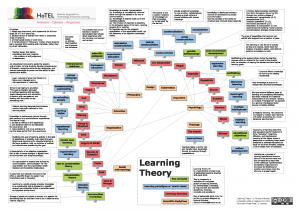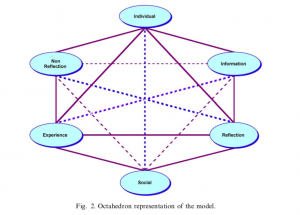
GIF from @GIFY by @criswiegandt
It was with great earnest that I began to survey the weeks reading’s, questing for the magical bean that would thereby only need to be planted to sprout into something of enormity that would transform the landscape and potentially lead to magical kingdoms in the sky. And, while the readings produced some concepts of interest that may begat further study, the magical bean was left uncovered. The sections below are my attempt to make sense of this literature and to determine its potential usefulness or,……. uselessness.
Key Reading Points:
Reading 1: Learning Design and Open Education
This article, by Conole (2018) examined the design of open education (MOOC’s and OER’s) and, the author argues that more engaging designs are needed, a comment I would agree with. A comprehensive look at the in’s and out’s of both provides the reader with an understanding of how each works, who uses each, what the barriers are and finally, why they are important. Also included is a detailed discussion around learning theories. One visual by Millwood that was included in this article and posted below; while, overwhelming to say the least, outlines these theories. If you are finding this hard to read and digest, it is more than just the terrible pixelation; here is a direct link, should you wish to peruse each in further detail. Learning Theory Diagram

What is even more amazing is the number of pieces represented within this diagram; it truly illustrates the complexity of teaching and learning.
Reading 2: Pedagogical Models for E-Learning: A Theory-Based Design Framework
“This paper presents a theory-based design framework for E-Learning that emphasizes the transformative interaction between pedagogical models, instructional strategies, and learning technologies” (Dabbagh,. 2005, p.25). After reviewing a number of theories, Dabbagh argues for distributed cognition to be used as the basis for E-learning. Dabbagh names three interconnected components required for effective implementation of E-Learning in connection with this : (1) pedagogical models or constructs, (2) instructional and learning strategies, and (3) pedagogical tools or online learning technologies. Dabbagh goes on to list a vast array of strategies, strategies that one could argue could also be connected to effective teaching in any situation, online or otherwise:
“(a) promoting or supporting authentic learning activities; (b) facilitating problem-solving, exploration, and hypothesis generation; (c) promoting collaboration and social negotiation; (d) supporting or facilitating role-playing activities; (e) promoting articulation and reflection; (f) supporting multiple perspectives; (g) supporting modeling and explaining; and (h) providing scaffolding.” (p.33)
This paper also illustrates the complexity of teaching, and the quest to find a fitting framework for E-Learning. As a nice addition, the author provides specific examples for each strategy. These specific examples may be helpful for all teachers, not only those who teach in an E-Learning environment.
Reading 3: Teaching online is different: Critical perspectives from the literature
Although based on higher education, this paper by Shé Ní, C., Farrell, O., Brunton, J., Costello, E., Donlon, E., Trevaskis, S., and Eccles, S. (2019) posited some interesting discussions and information connected to online teaching, online learning and the online teacher. While many of the strategies mentioned would be applicable regardless of the teaching environment, the authors do include aspects that would be unique to the online environment. One large consideration, when teaching online, are the skills needed, not only to run the class, but also to build and change courses. While we received little connected training on this at the school I currently work at, I am curious if other schools provide training, or if this is something typically only provided to those teaching higher education.
Also, as an online teacher, I found that some of the points made within this paper did not apply to my situation. For example, discussions around the inflexibility of the curriculum; not an issue in my workplace as we have full control over the content and the teacher has the authority to add, omit and adjust as needed. I believe that the larger challenge here is the teacher time it takes to create and modify courses, and the little time given to teachers to do this. Another point I connected with that was brought up within this paper, something that can be a quite a challenge, is accessibility. While this paper speaks to the importance of the accessibility of the teacher, one might argue that the accessibility of the student is equally important when it comes to success within the course. In the Moodle learning management system (LMS) we use, teachers and students have the ability to message each-other through the Moodle message system; however, one may wonder if there is a more effective messaging system that could be used as messages are often not responded to (in my experience with messaging ‘absent’ students). As students are not in front of you, it can become very challenging to help them to complete and submit assignments; perhaps a more effective messaging system or other forms of collaboration/community building could help with this. While these may be applicable and perhaps even necessary in high-school education, I wonder about the applicability of collaboration and community building within higher education, and would argue that while specific courses and programs lend themselves to this, others may not. I found it interesting that within this paper, as has been mentioned in a number of papers viewed recently, the TPACK model was mentioned as a possible construct for online learning and teaching. To see more of my thoughts and further details on this model, follow the link here.
Reading 4: Mapping Pedagogy and Tools for Effective Learning Design.
This paper by Conole, G., Dyke, M., Oliver, M., and Seale, J. (2004), looked at effective pedagogy and design by examining existing theories and models and their application to E-Learning. Within the discussion, overview charts were included that contained specific details connected to a variety of theories and models. The framework in Figure 2 below, was used in conjunction with learning theories mentioned: behaviourism, pre-conscious learning, reflective learning, experiential learning, learning in HE, conversational framework and communities of practice. The concluding thoughts presented are that the provision of a model such as this will give teachers a practical framework to help them navigate the many existing theories and models which may result in more thoughtfully informed pedagogy within an online construct. One benefit this framework may have is its apparent simplicity.
 (p.24)
(p.24)
Now WHAT?
After reflecting on this week’s readings, I would like to spend further time exploring some of the strategies included within these papers, a perceivably daunting task, to see if I can find ways to further develop, embed and include them within both the face-to face classes I teach and the online courses. While I often reflect on the pedagogy and strategies I use within the classroom, my reflection connected to the online components has primarily been connected to the content. Advances within the constructs and capabilities of the LMS system we use as well as thoughtful changes in the way I deliver both the face-to-face and online content, may allow for the creation of learning experiences that are more authentic, collaborative and engaging; and, that combine elements of the online and face-to face world in an effective, pedagogically based construct.
Perhaps the magical bean will be uncovered.
References
Conole, G., Dyke, M., Oliver, M., & Seale, J. (2004). Mapping pedagogy and tools for effective learning design. Computers & Education, 43(1–2), 17–33. Retrieved from https://doi.org/10.1016/j.compedu.2003.12.018
Conole, G. (2018). Learning Design and Open Education. International Journal of Open Educational Resources. Retrieved from https://www.ijoer.org/learning-design-and-open-education_doi-10-18278-ijoer-1-1-6/
Dabbagh, N. (2005). Pedagogical Models for E-Learning: A Theory-Based Design Framework. International Journal of Technology in Teaching and Learning, 1(1), 25–44. http://citeseerx.ist.psu.edu/viewdoc/download?doi=10.1.1.475.4593&rep=rep1&type=pdf
Huston, L (2019). Drip, drip, drop…. Models for technology integration (TPACK and SAMR). Teacher Talking Technology. Retrieved from https://teachertalkingtechnology.opened.ca/2019/09/23/drip-drip-drop-models-for-technology-integration-tpack-and-samr/preview_id=342&preview_nonce=20a83893c3&post_format=standard&_thumbnail_id=-1&preview=true
Millwood, R (n.d). Learning theory. Retrieved from https://proto-knowledge.blogspot.com/2015/09/overview-of-theories-of-learning.html
Shé Ní, C., Farrell, O., Brunton, J., Costello, E., Donlon, E., Trevaskis, S., & Eccles, S. (2019). Teaching online is different: Critical perspectives from the literature. Retrieved from Dublin City University website: http://doras.dcu.ie/23890/
Wiegandt, C (n.d). Tree growing GIF. Retrieved from https://giphy.com/gifs/plant-leaves-world-environment-day-ZZweDJbmPPLYiwQuf9